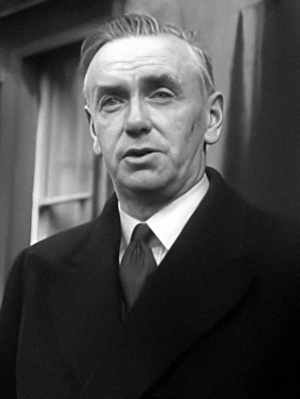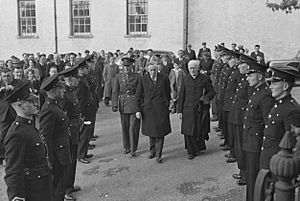John A. Costello facts for kids
Quick facts for kids
John A. Costello
|
|
|---|---|

Costello in 1948
|
|
| 3rd Taoiseach | |
| In office 2 June 1954 – 20 March 1957 |
|
| President | Seán T. O'Kelly |
| Tánaiste | William Norton |
| Preceded by | Éamon de Valera |
| Succeeded by | Éamon de Valera |
| In office 18 February 1948 – 13 June 1951 |
|
| President | Seán T. O'Kelly |
| Tánaiste | William Norton |
| Preceded by | Éamon de Valera |
| Succeeded by | Éamon de Valera |
| Leader of the Opposition | |
| In office 20 March 1957 – 21 October 1959 |
|
| President | Seán T. O'Kelly |
| Taoiseach | Éamon de Valera |
| Preceded by | Éamon de Valera |
| Succeeded by | James Dillon |
| In office 13 June 1951 – 2 June 1954 |
|
| President | Seán T. O'Kelly |
| Taoiseach | Éamon de Valera |
| Preceded by | Éamon de Valera |
| Succeeded by | Éamon de Valera |
| 3rd Attorney General of Ireland | |
| In office 9 January 1926 – 9 March 1932 |
|
| President | W. T. Cosgrave |
| Preceded by | John O'Byrne |
| Succeeded by | Conor Maguire |
| Teachta Dála | |
| In office February 1948 – June 1969 |
|
| Constituency | Dublin South-East |
| In office May 1944 – February 1948 |
|
| In office July 1937 – June 1943 |
|
| Constituency | Dublin Townships |
| In office January 1933 – July 1937 |
|
| Constituency | Dublin County |
| Personal details | |
| Born | 20 June 1891 Fairview, Dublin, Ireland |
| Died | 5 January 1976 (aged 84) Ranelagh, Dublin, Ireland |
| Resting place | Deans Grange Cemetery, Dublin, Ireland |
| Political party | Fine Gael |
| Spouse |
Ida Mary O'Malley
(m. 1919; died 1956) |
| Relations | Caroline Costello (granddaughter) |
| Children | 4; including Declan |
| Education |
|
| Alma mater |
|
John Aloysius Costello (born June 20, 1891 – died January 5, 1976) was an important Irish politician. He was a member of the Fine Gael political party. He served as the Taoiseach (Ireland's Prime Minister) twice. His first term was from 1948 to 1951, and his second was from 1954 to 1957. He was also the Leader of the Opposition and the Attorney General of Ireland. Costello was a Teachta Dála (TD), which is a member of the Irish Parliament, for many years.
Contents
Early Life and Education
John A. Costello was born in Fairview, Dublin, on June 20, 1891. His father, John Costello senior, worked for the government. His mother was Rose Callaghan. John went to school at St Joseph's, Fairview, and then to O'Connell School.
He later studied at University College Dublin. There, he earned a degree in modern languages and law. He then went to King's Inns to become a barrister, which is a type of lawyer. He won special awards there in 1913 and 1914. In 1914, he officially became a barrister and worked in this job until 1922.
Starting in Irish Politics
In 1922, Ireland became the Irish Free State. Costello joined the office of the Attorney General, who is the government's chief legal advisor. In 1926, he became the Attorney General himself. This happened when the Cumann na nGaedheal government, led by W. T. Cosgrave, was formed.
While he was Attorney General, Costello represented Ireland at important international meetings. He attended conferences about the Commonwealth of Nations and meetings of the League of Nations. He lost his job as Attorney General in 1932 when a different party, Fianna Fáil, came to power. However, the next year, he was elected to Dáil Éireann (the Irish Parliament) as a TD for Cumann na nGaedheal. Soon after, Cumann na nGaedheal joined with other parties to create Fine Gael.
Costello lost his seat in the 1943 election but won it back in 1944. From 1944 to 1948, he was the Fine Gael spokesperson for foreign affairs.
The 1948 General Election
By 1948, the Fianna Fáil party had been in power for 16 years. Many people blamed them for economic problems after World War II. In the 1948 Irish general election, Fianna Fáil won the most seats but did not have a clear majority. It looked like they would stay in power.
However, the other parties in the Dáil realized they could work together. If they combined their seats, they would have almost as many as Fianna Fáil. With the help of some independent politicians, they could form a government. So, Fine Gael, the Labour Party, the National Labour Party, Clann na Poblachta, and Clann na Talmhan decided to form Ireland's first ever "inter-party" or coalition government. They all shared a common goal: to replace Fianna Fáil and its leader, Éamon de Valera.
Taoiseach: First Term (1948–1951)
Since Fine Gael was the biggest party in this new coalition, they were expected to choose the Taoiseach. Many thought their leader, Richard Mulcahy, would get the job. But Clann na Poblachta and its leader, Seán MacBride, did not agree to Mulcahy. This was because of Mulcahy's role during the Irish Civil War.
Instead, Fine Gael and Clann na Poblachta agreed on John A. Costello as a compromise. Costello had never been a government minister before, and he was not involved in the Civil War. When he was told he would be nominated for Taoiseach, he was surprised. He was happy with his life as a lawyer and part-time politician. But his friends convinced him to accept the important role.
Declaring Ireland a Republic
During the election campaign, Clann na Poblachta had promised to get rid of the External Relations Act of 1936. This act kept Ireland linked to the British Commonwealth. Costello and his Tánaiste (Deputy Prime Minister), William Norton, also disliked this act.
In September 1948, Costello was visiting Canada. A reporter asked him if Ireland would leave the British Commonwealth. Costello then publicly announced that Ireland would indeed repeal the External Relations Act and declare itself a republic.
This news surprised the British government and even some of Costello's own ministers. Ireland officially left the Commonwealth on April 18, 1949, when the Republic of Ireland Act 1948 came into effect. The United Kingdom then passed the Ireland Act 1949. This act recognized the Republic of Ireland and confirmed that Northern Ireland would remain part of the UK as long as its people wished. It also gave full rights to Irish citizens living in the UK.
Many Irish nationalists felt that the division of Ireland was the last step to full independence. Costello made a formal protest against partition in May 1949, but it did not change anything.
The Mother and Child Scheme
In 1950, the Minister for Health, Noel Browne, proposed a new plan called the Mother and Child Scheme. This plan aimed to give free medical care to mothers during pregnancy and to children up to age sixteen. This kind of care was common in other parts of Europe.
However, some doctors and Catholic bishops opposed the plan. Doctors worried about losing income. Bishops had concerns about the plan's details. The government itself was divided, with some feeling the country could not afford the yearly cost. Facing this opposition, Costello and other ministers did not support the plan. Noel Browne resigned from the government in April 1951, and the scheme was stopped.
Achievements of the First Coalition
Costello's first government achieved several important things. They built a record number of new homes. They also created new organizations like the Industrial Development Authority to help Irish businesses. The Minister for Health, Noel Browne, also made progress in treating tuberculosis using a new medicine called Streptomycin. Ireland also joined international groups like the Organization for European Economic Co-operation and the Council of Europe. The plan to bring electricity to even the most remote parts of Ireland was also sped up.
Election Defeat in 1951
Even though the "Mother and Child" issue caused some problems, it did not cause the government to fall. However, prices were going up, and there were economic difficulties. Two TDs also stopped supporting the government. Because of these pressures, Costello decided to call a 1951 Irish general election in June 1951. The election results were not clear, but Fianna Fáil returned to power. Costello resigned as Taoiseach. In this election, Costello's son, Declan, was also elected to the Dáil.
For the next three years, while Fianna Fáil was in power, Costello remained an important leader for Fine Gael in Parliament. He also went back to working as a barrister.
Taoiseach: Second Term (1954–1957)
In the 1954 Irish general election, Fianna Fáil lost power. A new government was formed by Fine Gael, the Labour Party, and Clann na Talmhan. John A. Costello became Taoiseach for the second time.
This government faced challenges with Ireland's economy. Many people were leaving Ireland to find work, and unemployment was high. Global events, like the Suez Crisis, also made things difficult. The government tried to help the economy, for example, by offering tax relief for exports in 1956. These changes would take time to show big results.
Costello's government did have some successes. Ireland became a member of the United Nations in 1955. Also, a very successful visit to the United States in 1956 started a tradition. Since then, the Taoiseach visits the White House every St. Patrick's Day to give the US President a bowl of shamrock.
Even though the government had a good number of seats in Parliament, new activity by the IRA in Northern Ireland and Great Britain caused problems. The Irish government took strong action against these republican groups.
In 1957, Seán MacBride, the leader of Clann na Poblachta, proposed a motion of no confidence against the government. This was because of the struggling economy and the government's actions against the IRA. Fianna Fáil also put forward their own motion. Rather than face a sure defeat, Costello asked President Seán T. O'Kelly to dissolve the Parliament. The 1957 Irish general election that followed gave Fianna Fáil a clear majority. This began another 16 years of their rule. Some people thought Costello called the election because he was tired of politics and sad after his wife's death the year before.
Later Life and Retirement
After his government was defeated, Costello returned to working as a barrister. In 1959, when Richard Mulcahy stepped down as leader of Fine Gael, Costello decided to move to the backbenches of Parliament. He could have become the party leader if he had wanted to work full-time in that role.
He remained a TD until 1969, when he retired from politics. Garret FitzGerald, who later became Taoiseach himself, took over his seat for Dublin South-East.
During his life, Costello received many awards from universities in the United States. He also became a member of the Royal Irish Academy in 1948. In March 1975, he was given the special honor of being made a freeman of the city of Dublin, along with his old political rival, Éamon de Valera. He continued to work as a lawyer almost until his death. John A. Costello passed away in Dublin on January 5, 1976, at the age of 84.
Governments Led by John A. Costello
- 5th Government of Ireland (February 1948 – June 1951)
- 7th Government of Ireland (June 1954 – March 1957)
See also
 In Spanish: John A. Costello para niños
In Spanish: John A. Costello para niños
- List of people on stamps of Ireland


